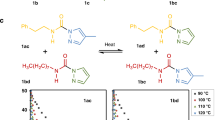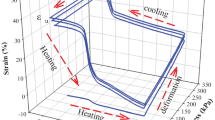Abstract
Stimulus-responsive polymers containing dynamic bonds enable fascinating properties of self-healing, recycling and reprocessing due to enhanced relaxation of polymer chain/network with labile linkages. Here, we study the structure and properties of a new type of thermoplastic polyurethanes (TPUs) with trapped dynamic covalent bonds in the hard-phase domain and report the frustrated relaxation of TPUs containing weak dynamic bond and π-π interaction in hard segments. As detected by rheometry, the aromatic TPUs with alkyl disulfide in the hard segments possess the maximum network relaxation time in contrast to those without dynamic bonds and alicyclic TPUs. In situ FTIR and small-angle scattering results reveal that the alkyl disulfide facilitates stronger intermolecular interaction and more stable micro-phase morphology in π-π interaction based aromatic TPUs. Molecular dynamics simulation for pure hard segments of model molecules verify that the presence of disulfide bonds leads to stronger π-π stacking of aromatic rings due to both enhanced assembling thermodynamics and kinetics. The enhanced π-π packing and micro-phase structure in TPUs further kinetically immobilize the dynamic bond. This kinetically interlocking between the weak dynamic bonds and strong molecular interaction in hard segments leads to much slower network relaxation of TPU. This work provides a new insight in tuning the network relaxation and heat resistance as well as molecular self-assembly in stimulus-responsive dynamic polymers by both molecular design and micro-phase control toward the functional applications of advanced materials.
Similar content being viewed by others
References
Ghosh, B.; Urban, M. W. Self-repairing oxetane-substituted chitosan polyurethane networks. Science 2009, 323, 1458–1460.
Cordier, P.; Tournilhac, F.; Soulie-Ziakovic, C.; Leibler, L. Sel-healing and thermoreversible rubber from supramolecular assembly. Nature 2008, 451, 977–980.
Li, Y.; Sun, J. Self-healing and healable polymeric materials based on polymer complexes. Acta Polymerica Sinica (in Chinese) 2020, 51, 791–803.
Lendlein, A.; Jiang, H.; Junger, O.; Langer, R. Light-induced shape-memory polymers. Nature 2005, 434, 879–882.
Zheng, N.; Fang, Z.; Zou, W.; Zhao, Q.; Xie, T. Thermoset shape-memory polyurethane with intrinsic plasticity enabled by transcarbamoylation. Angew. Chem. Int. Ed. 2016, 128, 11421–11425.
Christensen, P. R.; Scheuermann, A. M.; Loeffler, K. E.; Helms, B. A. Closed-loop recycling of plastics enabled by dynamic covalent diketoenamine bonds. Nat. Chem. 2019, 11, 442–448.
Montarnal, D.; Capelot, M.; Tournilhac, F.; Leibler, L. Silica-like malleable materials from permanent organic networks. Science 2011, 334, 965–968.
Yang, Y.; Pei, Z.; Li, Z.; Wei, Y.; Ji, Y. Making and remaking dynamic 3D structures by shining light on flat liquid crystalline vitrimer films without a mold. J. Am. Chem. Soc. 2016, 138, 2118–2121.
Kuang, X.; Liu, G.; Dong, X.; Wang, D. Correlation between stress relaxation dynamics and thermochemistry for covalent adaptive networks polymers. Mater. Chem. Front. 2017, 1, 111–118.
Adzima, B. J.; Aguirre, H. A.; Kloxin, C. J.; Scott, T. F.; Bowman, C. N. Rheological and chemical analysis of reverse gelation in a covalently cross-linked Diels-Alder polymer network. Macromolecules 2008, 41, 9112–9117.
Chen, X.; Dam, M. A.; Ono, K.; Mal, A.; Shen, H.; Nutt, S. R.; Sheran, K.; Wudl, F. A thermally re-mendable cross-linked polymeric material. Science 2002, 295, 1698–1702.
Kuang, X.; Liu, G.; Dong, X.; Wang, D. Triple-shape memory epoxy based on Diels-Alder adduct molecular switch. Polymer 2016, 84, 1–9.
Kuang, X.; Liu, G.; Zheng, L.; Li, C.; Wang, D. Functional polyester with widely tunable mechanical properties: the role of reversible cross-linking and crystallization. Polymer 2015, 65, 202–209.
Oehlenschlaeger, K. K.; Mueller, J. O.; Brandt, J.; Hilf, S.; Lederer, A.; Wilhelm, M.; Graf, R.; Coote, M. L.; Schmidt, F. G.; Barner-Kowollik, C. Adaptable hetero Diels-Alder networks for fast self-healing under mild conditions. Adv. Mater. 2014, 26, 3561–3566.
Michal, B. T.; Jaye, C. A.; Spencer, E. J.; Rowan, S. J. Inherently photohealable and thermal shape-memory polydisulfide networks. ACS Macro Lett. 2013, 2, 694–699.
Barcan, G. A.; Zhang, X.; Waymouth, R. M. Structurally dynamic hydrogels derived from 1,2-dithiolanes. J. Am. Chem. Soc. 2015, 137, 5650–5653.
Deng, J.; Kuang, X.; Liu, R.; Ding, W.; Wang, A. C.; Lai, Y. C.; Dong, K.; Wen, Z.; Wang, Y.; Wang, L.; Qi, H. J.; Zhang, T.; Wang, Z. L. Vitrimer elastomer-based jigsaw puzzle-like healable triboelectric nanogenerator for self-powered wearable electronics. Adv. Mater. 2018, 30, 1705918.
Taynton, P.; Yu, K.; Shoemaker, R. K.; Jin, Y.; Qi, H. J.; Zhang, W. Heat- or water-driven malleability in a highly recyclable covalent network polymer. Adv. Mater. 2014, 26, 3938–3942.
Lei, X.; Jin, Y.; Sun, H.; Zhang, W. Rehealable imide-imine hybrid polymers with full recyclability. J. Mater. Chem. A 2017, 5, 21140–21145.
Zhao, S.; Abu-Omar, M. M. Recyclable and malleable epoxy thermoset bearing aromatic imine bonds. Macromolecules 2018, 51, 9816–9824.
Zou, Z.; Zhu, C.; Li, Y.; Lei, X.; Zhang, W.; Xiao, J. Rehealable, fully recyclable, and malleable electronic skin enabled by dynamic covalent thermoset nanocomposite. Sci. Adv. 2018, 4, eaaq0508.
Lessard, J. J.; Garcia, L. F.; Easterling, C. P.; Sims, M. B.; Bentz, K. C.; Arencibia, S.; Savin, D. A.; Sumerlin, B. S. Catalyst-free vitrimers from vinyl polymers. Macromolecules 2019, 52, 2105–2111.
Capelot, M.; Unterlass, M. M.; Tournilhac, F.; Leibler, L. Catalytic control of the vitrimer glass transition. ACS Macro Lett. 2012, 1, 789–792.
Capelot, M.; Montarnal, D.; Tournilhac, F.; Leibler, L. Metal-catalyzed transesterification for healing and assembling of thermosets. J. Am. Chem. Soc. 2012, 134, 7664–7667.
Pei, Z.; Yang, Y.; Chen, Q.; Terentjev, E. M.; Wei, Y.; Ji, Y. Mouldable liquid-crystalline elastomer actuators with exchangeable covalent bonds. Nat. Mater. 2014, 13, 36–41.
Yu, K.; Shi, Q.; Dunn, M. L.; Wang, T. J.; Qi, H. J. Carbon fiber reinforced thermoset composite with near 100% recyclability. Adv. Funct. Mater. 2016, 26, 6098–6106.
Lei, Z. Q.; Xiang, H. P.; Yuan, Y. J.; Rong, M. Z.; Zhang, M. Q. Room-temperature self-healable and remoldable cross-linked polymer based on the dynamic exchange of disulfide bonds. Chem. Mater. 2014, 26, 2038–2046.
Hentschel, J.; Kushner, A. M.; Ziller, J.; Guan, Z. Self-healing supramolecular block copolymers. Angew. Chem. Int. Ed. 2012, 51, 10561–10565.
Wang, C.; Wu, H.; Chen, Z.; McDowell, M. T.; Cui, Y.; Bao, Z. Self-healing chemistry enables the stable operation of silicon microparticle anodes for high-energy lithium-ion batteries. Nat. Chem. 2013, 5, 1042–1048.
Wang, C.; Liu, N.; Allen, R.; Tok, J. B. H.; Wu, Y.; Zhang, F.; Chen, Y.; Bao, Z. A rapid and efficient self-healing thermo-reversible elastomer crosslinked with graphene oxide. Adv. Mater. 2013, 25, 5785–5790.
Tang, X.; Feula, A.; Baker, C. B.; Melia, K.; Merino, H. D.; Hamley, W. I.; Buckley, P. C.; Hayes, W.; Siviour, R. C. A dynamic supramolecular polyurethane network whose mechanical properties are kinetically controlled. Polymer 2017, 133, 143–150.
Mozhdehi, D.; Ayala, S.; Cromwell, O. R.; Guan, Z. Self-healing multiphase polymers via dynamic metal-ligand interactions. J. Am. Chem. Soc. 2014, 136, 16128–16131.
Berezkin, Y.; Urick, M. In Modern polyurethanes: overview of structure property relationship. ACS Symp. Ser, ACS Publications, 2013, p. 65–81.
Engels, H. W.; Pirkl, H. G.; Albers, R.; Albach, R. W.; Krause, J.; Hoffmann, A.; Casselmann, H.; Dormish, J. Polyurethanes: versatile materials and sustainable problem solvers for today’s challenges. Angew. Chem. Int. Ed. 2013, 52, 9422–9441.
Xiang, D.; He, J.; Cui, T.; Liu, L.; Shi, Q. S.; Ma, L. C.; Liang, Y. Multiphase structure and electromechanical behaviors of aliphatic polyurethane elastomers. Macromolecules 2018, 51, 6369–6379.
Velankar, S.; Cooper, S. L. Microphase separation and rheological properties of polyurethane melts. 2. Effect of block incompatibility on the microstructure. Macromolecules 2000, 33, 382–394.
Yu, S.; Zhang, R.; Wu, Q.; Chen, T.; Sun, P. Bio-inspired highperformance and recyclable cross-linked polymers. Adv. Mater. 2013, 25, 4912–4917.
Heo, Y.; Sodano, H. A. Self-healing polyurethanes with shape recovery. Adv. Funct. Mater. 2014, 24, 5261–5268.
Liu, W. X.; Zhang, C.; Zhang, H.; Zhao, N.; Yu, Z. X.; Xu, J. Oxime-based and catalyst-free dynamic covalent polyurethanes. J. Am. Chem. Soc. 2017, 139, 8678–8684.
Ying, H.; Cheng, J. Hydrolyzable polyureas bearing hindered urea bonds. J. Am. Chem. Soc. 2014, 136, 16974–16977.
Kang, J.; Son, D.; Wang, G.-J. N.; Liu, Y.; Lopez, J.; Kim, Y.; Oh, J. Y.; Katsumata, T.; Mun, J.; Lee, Y.; Jin, L.; Tok, J. B. H.; Bao, Z. Tough and water-insensitive self-healing elastomer for robust electronic skin. Adv. Mater. 2018, 30, 1706846.
Zhang, Q.; Niu, S.; Wang, L.; Lopez, J.; Chen, S.; Cai, Y.; Du, R.; Liu, Y.; Lai, J. C.; Liu, L.; Li, C. H.; Yan, X.; Liu, C.; Tok, J. B. H.; Jia, X.; Bao, Z. An elastic autonomous self-healing capacitive sensor based on a dynamic dual crosslinked chemical system. Adv. Mater. 2018, 30, 1801435.
Jin, B.; Song, H.; Jiang, R.; Song, J.; Zhao, Q.; Xie, T. Programming a crystalline shape memory polymer network with thermo-and photo-reversible bonds toward a single-component soft robot. Sci. Adv. 2018, 4, eaao3865.
Zhao, Q.; Zou, W.; Luo, Y.; Xie, T. Shape memory polymer network with thermally distinct elasticity and plasticity. Sci. Adv. 2016, 2, e1501297.
Xu, W. M.; Rong, M. Z.; Zhang, M. Q. Sunlight driven self-healing, reshaping and recycling of a robust, transparent and yellowing-resistant polymer. J. Mater. Chem. A 2016, 4, 10683–10690.
Rekondo, A.; Martin, R.; de, Luzuriaga A. R.; Cabanero, G.; Grande, H. J.; Odriozola, I. Catalyst-free room-temperature self-healing elastomers based on aromatic disulfide metathesis. Mater. Horiz. 2014, 1, 237–240.
Xu, Y.; Chen, D. A novel self-healing polyurethane based on disulfide bonds. Macromol. Chem. Phys. 2016, 217, 1191–1196.
Zhang, L.; Chen, L.; Rowan, S. J. Trapping dynamic disulfide bonds in the hard segments of thermoplastic polyurethane elastomers. Macromol. Chem. Phys. 2017, 218, 1600320.
Kim, S. M.; Jeon, H.; Shin, S. H.; Park, S. A.; Jegal, J.; Hwang, S. Y.; Oh, D. X.; Park, J. Superior toughness and fast self-healing at room temperature engineered by transparent elastomers. Adv. Mater. 2018, 30, 1705145.
Lai, Y.; Kuang, X.; Zhu, P.; Huang, M.; Dong, X.; Wang, D. Colorless, transparent, robust, and fast scratch-self-healing elastomers via a phase-locked dynamic bonds design. Adv. Mater. 2018, 30, 1802556.
Carlsson, D. J.; Wiles, D. M. The photodegradation of polypropylene films. II. Photolysis of ketonic oxidation products. Macromolecules 1969, 2, 587–597.
Tobin, M. C. The infrared spectra of polymers. III. The infrared and Raman spectra of isotactic polypropylene. J. Phys. Chem. 1960, 64, 216–219.
Jorgensen, W. L.; Maxwell, D. S.; Tirada-Rives, J. J. Development and testing of the OPLS all-atom force field on conformational energetics and properties of organic liquids. Chem. Soc. 1996, 118, 11225–11236.
Berendsen, H. J. C.; van der Spoel, D.; van Drunen, P. GROMACS: A message-passing parallel molecular dynamics implementation. Comp. Phys. Commun. 1995, 91, 43–56.
Lindahl, E.; Hess, B.; van der Spoel, D. GROMACS 3.0: a package for molecular simulation and trajectory analysis. Mol. Model. 2001, 7, 306–317.
Kuang, X.; Chen, K.; Dunn, C. K.; Wu, J.; Li, V. C.; Qi, H. J. 3D printing of highly stretchable, shape-memory and self-healing elastomer toward novel 4D printing. ACS Appl. Mater. Interfaces 2018, 101, 7381–7388.
Denes, F.; Pichowicz, M.; Povie, G.; Renaud, P. Thiyl radicals in organic synthesis. Chem. Rev. 2014, 114, 2587–2693.
Hunter, C. A.; Sanders, J. K. The nature of n-n interactions. J. Am. Chem. Soc. 1990, 112, 5525–5534.
Acknowledgments
This work was financially supported by the National Natural Science Foundation of China (No. 21774135).
Author information
Authors and Affiliations
Corresponding author
Electronic supplementary material
Rights and permissions
About this article
Cite this article
Lai, Y., Kuang, X., Yang, WH. et al. Dynamic Bonds Mediate π-π Interaction via Phase Locking Effect for Enhanced Heat Resistant Thermoplastic Polyurethane. Chin J Polym Sci 39, 154–163 (2021). https://doi.org/10.1007/s10118-020-2494-7
Received:
Accepted:
Published:
Issue Date:
DOI: https://doi.org/10.1007/s10118-020-2494-7




